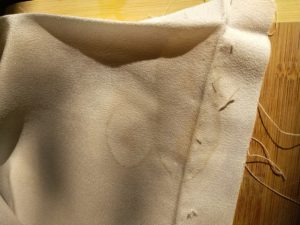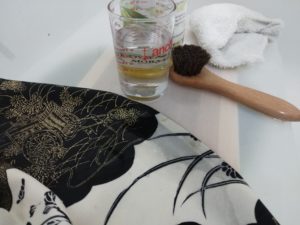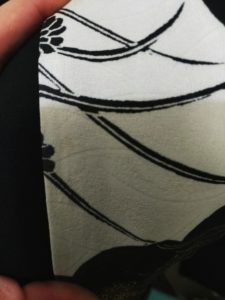Kimono Cleaning
now browsing by category
Cleaning My White Juban and Kimono 私の白いジュバンと着物を洗う

Cleaning your precious kimono is never a light undertaking. What is it made of? What kind of stain is it? How long has the stain been there? Is there someone in town that knows how to clean kimono? Can I afford to have it cleaned professionally? Do I want to take it completely apart to clean it or spot clean it?
This and many other questions such as “Why?? Why do I own so many kimono and how is it I never noticed that stain before??” may cross your mind.
A conversation with a friend brought forward some great info – One of her aunts used to clean and restore silk clothing and she had some advice for a mixture that her aunt used.
Lemon juice, water and sunshine.
Unfortunately her aunt never told her the exact measurements of the mixture she used.
Knowing what the ingredients are to a recipe doesn’t mean you’re going to get a cake at the end.
WARNING/Disclaimer – This is my own experimentation with spot cleaning kimono and juban. Please make note that so far I have only worked on white or ivory areas of a kimono. I have not tried to remove stains from a dark kimono!
Self cleaning is not without it’s ups, downs and unexpecteds, and you have to be keeping a close eye on your clothes to catch anything you didn’t expect to happen – see my notes below.
If you choose to try my mixture you do it at your own peril.
So on to the experimentation!
I began first with a Polyester Juban that I had picked apart. I wasn’t worried if there was any damage to it or spots left after the treatment because I figured I’d cover the ones on the collar with a han’eri anyway.and the hem ones would disappear when I shortened it.
That is what I tried first.
Online I found a recipe for a 1-1-1 mixture of lemon juice, water and baking soda.
NOTE: I have heard more than once that fresh squeezed lemon juice is the best. I have not experimented with any bottled lemon juice.
The baking soda will bubble when it hits the lemon juice and then eventually settles to the bottom, so make sure to stir each time you go to apply.
I applied the juice mixture to the hem of my juban with a Qtip. Trying to keep the moisture as concentrated on the exact spots as possible, which as it turns out is almost impossible, but you can get close. Then I set it out in the sun to dry, my friend’s aunt emphasized that setting it in direct sunlight was very important. This first time I only let it dry in the sun for about 15 minutes because I noticed a horrible “Wet stain” appearing on the material.
So next I took it in to the tub and I used a natural castile soap, a soft horse hair brush (I had recently seen a kimono cleaner on Instagram using a soft horse hair brush to scrub kimono), and cool water (Don’t use hot water, it’s likely to set the stain and/or damage the fabric fibers). I scrubbed gently a few minutes on both sides of the juban. Attacking the stain from both sides seems to work best, although this will not always be possible, such as an awase kimono. Now rinse.
The “wet stain” disappeared and to my delight the stains were much lighter than before.
I repeated the process and ended up with stains so very pale that the camera couldn’t pick it up and a friend had to really search on the fabric to find the ones at the hem.
But I am a perfectionist and pale stains still weren’t good enough.
So the next day I tried a slightly different approach. I used a bit more lemon juice this time.
3 TBSPs Lemon juice
2 TBSPs water
2 tsps baking soda
I let the garment sit in the sun for much longer, about an hour, before rinsing it with castile soap.
Very high tech. My poor juban is laying on a plastic trash bag while the part that needs to be in the sunshine is draped across a bucket with a plastic cutting board on it to give it a flat surface. (Where there’s a will there is a way!)
And VOILA the stains completely disappeared!
Now it was truly time to be ambitious! Silk.
I pulled out a vintage silk autumn kimono I had just received from Japan. It was mainly ivory with a black and gold kyo-yuzen design. There were only a few stains on it. Two on the collar and one at the right seam – below where the ohashori would hide it.
I pulled out the 3TBSP Lemon Juice, 2 TBSP water and 2 tsp Baking soda mixture and used it.
For the spots on the collar I washed it first with the castile soap and set it out to dry.
That didn’t seem to make any difference at all in the stains, so after 40 minutes of letting it dry outside I went and applied the Lemon juice mixture with a Qtip as I had before and let it sit for another 45 min in the sunlight.
Then I brought it in and washed it, gently scrubbing with the horse hair brush. The stains were definitely lighter!! So I let it sit in the sunshine until it was dry and applied the lemon juice again to the collars and to the stain on the seam and let it sit in the sunshine for another hour, and again washed/rinsed. The stains on the collar are lighter again, but I’m still going for another round.
The real success story was the stain near the okuni line. One application of lemon juice, one hour of sunshine, and one rinse and it was gone!
Have patience with your kimono. It took me at least 3 applications and 3-5 hours of letting it rest in the sun to get the results that I did. I am sure there are stains that could take longer, just as there are stains that take less time.
NOTE: Be very cautious if you have an awase kimono with a dark lining. I noticed in one area of my silk kimono, when I got it too wet, that the color of the lining was beginning to stain the kimono. Fortunately I caught it quickly, washed with castile soap and scrubbed gently with the brush and air dried it with a fan, which seemed to keep the lining from touching the kimono fabric.
NOTE: I would not try this technique on dark kimonos. Lemon has a bleaching quality and I can tell you that there is one small spot on the black clouds up by the collar stain that I caught beginning to bleach to grey/blue where some lemon juice had gotten on it. I quickly placed a piece of fabric over it to get it out of the sun. In fact if there are large areas of dark in your pattern I would shield that from the sun as much as possible while you work on the stains in the light areas of your kimono.























 D5 Creation
D5 Creation